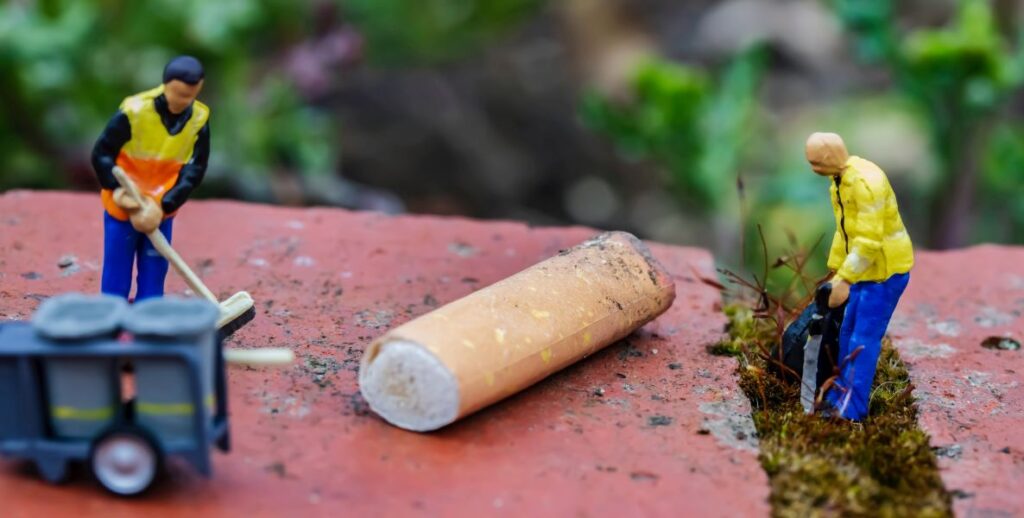Philadelphia’s public spaces suffer from two main types of improper waste disposal: littering and illegal dumping. Litter consists of small pieces of trash that are either tossed on the ground or spilled during the garbage collection process. Illegal dumping consists of larger, heavier kinds of waste that are intentionally deposited by contractors, auto shops, junk haulers and/or residents.
Fighting litter and illegal dumping requires at least a two-fold approach: reducing the amount of trash that ends up in the street and increasing our capacity to remove the trash that does. For decades, the City’s reduction and removal efforts have been woefully inadequate — hence, our embarrassing alias, “Filthadelphia.” But in 2019, the outlook was finally starting to look a bit better.
Nic Esposito was leading the Kenney administration’s Zero Waste and Litter Cabinet, and through it, he was advancing a technology that promised to help the city reduce occurrences of illegal dumping. Meanwhile, Morgan Berman had just founded street-cleaning startup Glitter, which promised to provide a sorely needed supplement to the City’s litter-removal efforts. All City leadership had to do was keep Esposito’s momentum rolling and give Berman the limited assistance she needed to get Glitter off the ground.
Had the City managed that much, who knows how much progress might have been made over the last three years— especially in our poorest neighborhoods, where litter and illegal dumping tend to be the worst. But the City did not manage that much.
These solutions are still sitting there, right in the City’s lap, just waiting to be put to good use. Every day our leaders ignore them, our poorest neighborhoods suffer the most.
Here’s the story of how Philadelphia’s municipal leaders have failed — so far — to capitalize on two solutions to our trash crisis that were dropped right in their lap.
An algorithm for catching illegal dumpers
Illegal dumping costs Philadelphia more than $8 million per year. It occurs most frequently in the city’s poorest neighborhoods, where individuals go to dump materials — in vacant lots, parks, even in the middle of neglected streets — because, as long as they don’t get caught, it’s far cheaper to dump things illegally than to dispose of them properly.
The City has laws on the books imposing fines on illegal dumpers. It’s the catching that’s the problem; illegal dumping is often done at night and in low-traffic areas, where dumpers know they’re out of law enforcement’s eyeshot. Hence the frequent calls by residents for camera installation: If you can capture dumping on camera, then you have a better chance at catching those responsible.

What the City really needs, then, is a method for making better use of the surveillance footage it already has. Turns out, the group of researchers for the aforementioned Penn project developed a technology capable of doing precisely that, and in 2019, the City was on track to adopt it.
As the city’s so-called Litter Czar, one of Nic Esposito’s primary roles was to facilitate communication between departments and with external collaborators to solve pressing problems. “The City has the talent,” Esposito says, “but not the organization and leadership,” which he strove to provide as cabinet director. Esposito was working with the Streets Department, the Police Department’s Environmental Crimes Unit, and those Penn researchers, led by professor Dan Hopkins, a member of Esposito’s cabinet.
Hopkins’ team worked closely with City officials over a period of several months to develop what their report calls “machine learning software which can be run on video extracted from city CCTV feeds to identify the timing and location of acts of illegal dumping as they happen.” The initial algorithm they came up with had approximately 60 percent accuracy and a user-friendly interface. As reported by Penn Today in 2019:
The students essentially built a computer brain that could learn what certain items were in the video feed … like black trash bags, wooden beams from a house demolition, and tires. The algorithm could very quickly look through the footage to find those things.
But algorithms don’t improve or learn on their own. They must be “trained,” or fed video, in order to accurately detect relevant activity. In order for the program to work, the students running it would need consistent communication with City officials to access data. Esposito’s role as go-between would ensure an essential open channel.
Here’s the kicker: the tech is trivially cheap. Hopkins’ team anticipated an annual price tag of roughly $100,000. A $100,000 solution to an $8 million problem is an absolute no-brainer.
For their part, according to this same report, City officials were “excited by the prospect of modernizing their technological infrastructure and having the tools necessary to monitor an increasing number of security cameras.” Everything was in place for a citywide crackdown on illegal dumping.
Then came Covid. Kenney let Esposito go and dissolved his cabinet, as part of pandemic-induced budget cuts. Without Esposito to facilitate communication and data-sharing, progress on the illegal dumping surveillance algorithm ceased. Illegal dumping, however, did not. Two years later, the practice is more prevalent than ever, and the City still has not resumed rolling out a technology that promises to enable desperately needed enforcement.
A Streets Department spokesperson confirmed that the algorithm idea was presented to Esposito’s litter cabinet but said the idea has not come up for formal departmental review. Perhaps that opportunity still exists. “The City is open to exploring ways to support our continued efforts to address illegal dumping across the City,” they say. (What’s more, Hopkins and his students remain poised to complete the job.)
And here’s the kicker: the tech is trivially cheap. Hopkins’ team anticipated an annual price tag of roughly $100,000. Recall that illegal dumping costs the city more than $8 million annually. A $100,000 solution to an $8 million problem is an absolute no-brainer.
A subscription-based street neighborhood cleanup service
The Kenney administration recently began rolling out phase two of its street sweeping pilot. While the program promises to get some of the filth off our streets, Morgan Berman pointed out that it clears sidewalks with gasoline-powered backpack blowers, which contribute to air pollution. Glitter, which Berman sees as a cheaper and environmentally friendlier supplement to the city’s street sweeping program, could clean many of the blocks that need it most — and it could do so weekly, including sidewalks — and without blowers.
In 2019, Berman’s vision for Glitter was to have Philly residents download an app through which they could report litter sightings. Glitter would then send a team of paid cleaners to reported locations, clean up the litter, log their cleanup in Glitter’s system, and get paid for each block they cleared. Funding would come largely from the City, though residents would be able to contribute to support cleanups in their neighborhoods.
Having worked closely with councilmembers Mark Squilla and Derek Green and received feedback from Streets Commissioner Carlton Williams, Berman earned Glitter a spot in the City’s FY2020 budget. This was exciting news, because the Knight Foundation had told Berman they’d provide her with additional funding if she secured a City contract.
But after Williams failed to show up for a scheduled meeting, support from the Streets Department waned, and Glitter’s funding got axed. When asked for a reason, the City said that it was “not going to pay for an unproven pilot program.” Losing the City’s support meant losing the Knight Foundation’s, too.
Not one to give up, Berman brought on Brandon Pousley as CEO, and, together, they’ve willed a new version of Glitter into existence. They’ve effectively scrapped the app. Glitter now functions primarily through its website and is crowd-funded through a block subscription model. For $200 a month, Glitter provides weekly cleanups for one city block — including the street, sewer grates and sidewalks. If 10 people want to see one block cleaned, they each pay $20 per month. Anyone can contribute money to any block. It’s most intuitive that people would pay for block cleanings in their own neighborhoods, but in theory, a group of wealthy Washington Square residents could easily pay for weekly cleanups of a block in Strawberry Mansion.
The budget hasn’t been finalized for FY2023 yet, and a new wave of mayoral candidates are gearing up to launch their campaigns. If Kenney leaves office without using these ready-made solutions to clean up our city, then we should be ready to demand better from his successor.
So far, Glitter’s team of 10 paid cleaners have been doing regular block cleanings for the last six months. Each week, they clean over 60 blocks scattered throughout every section of the city, and that number is growing by the week. If the Streets Department once balked at funding Glitter because it was an unproven pilot, the last six months have rendered that excuse illegitimate.
Berman and Pousley have Glitter primed to expand, with the company gearing up for its largest hiring wave ever. That their service Glitter needs to exist, given that street cleaning is traditionally a public sector problem, is bewildering. That Glitter has yet to receive public sector support, well, that’s demoralizing.
The City’s Litter Index found that Philly has around 10,000 blocks with moderate to severe litter conditions. Many of those blocks are in under-resourced neighborhoods. Even with Glitter’s impact fund, it’s unlikely the company will match the scale of the city’s litter problem any time soon. Unless, of course, the City gives them a major funding boost. Starting small and targeting just the dirtiest 1,000 blocks in the city, at $200 per block per month, puts the price tag at $2.4 million for the first year. In a city with an annual budget of over $5.6 billion, that’s barely a drop in the bucket.
The smart, clean solution
The City of Philadelphia, then, could go a long way toward solving its trash crisis by devoting just $2.5 million to solutions already sitting in its lap. The solutions came from local innovators who have all but begged the City to let them do what elected leaders have failed to: crack down on illegal dumping and ramp up litter removal.
But it’s not too late for leaders to take credit for the work done by Esposito, Hopkins, Berman, and Pousley. The budget hasn’t been finalized for FY2023 yet, and a new wave of mayoral candidates are gearing up to launch their campaigns. If Kenney leaves office without using these ready-made solutions to clean up our city, then we should be ready to demand better from his successor.
I, for one, am prepared to vote for any qualified candidate willing to endorse these two solutions. The bar is low. The stakes are high. Just end the garbage deluge.
The Citizen is one of 20 news organizations producing Broke in Philly, a collaborative reporting project on solutions to poverty and the city’s push towards economic mobility. Follow the project on Twitter @BrokeInPhilly.
Reality Check: One Word to Fix Philly’s Trash Crisis? Invest.

